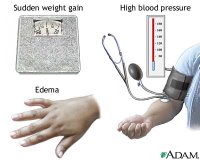
Eclampsia is preeclampsia plus seizures. It may develop if preeclampsia is not controlled or it may develop even without prior development of preeclampsia. It is a life-threatening emergency condition affecting all women of all ages usually occurring prior to delivery. The risk usually increases in multiple gestations, molar pregnancy, nulliparous women age 35 and above, strong family history, and those with secondary conditions like hypertension and kidney disease. It can cause permanent damage to the vital organs and can even lead to coma or death if left untreated.
The exact cause of eclampsia is still unknown. Some researchers relate it to the placenta and fetal membranes because of improvement of the condition following delivery. Just like preeclampsia, there is also severe headache, epigastric or right upper quadrant pain, and problems in vision. The only difference is the presence of seizures in eclampsia. The patient may have only one or more than one episode of seizure which may last for 1 minute or more. This may be accompanied by protrusion of the eyes, foaming of the mouth, and stopping of breathing during the episode. This accounts for the damage to the vital organs and to the central nervous system. This can also cause the death of the baby or if not can lead to prematurity, intrauterine growth retardation, decreased oxygen delivered to the baby, or premature separation of the placenta from the inner linings of the uterus.
Magnesium sulfate is the drug given to the mother to prevent further occurrence of seizures. Delivery of the baby is the treatment of choice especially if the baby is already 28 weeks of gestation. Below this, management should be weighed between the viability of the fetus and the resulting complications to the mother and child. |